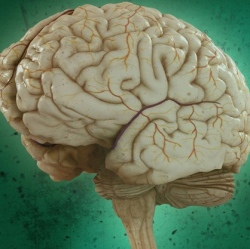
Scientists have identified an area of the brain that may give humans unique abilities, including language. The area lit up in human, but not monkey, brains when they were presented with types of abstract information. The idea that integrating abstract information drives many of the human brain’s unique abilities.
But a paper published in Current Biology, which directly compares activity in human and macaque monkey brains as they listen to simple auditory patterns, provides the first physical evidence that a specific area for such integration may exist in humans. Other studies that compare monkeys and humans have revealed differences in the brain’s anatomy, for example, but not differences that could explain where humans’ abstract abilities come from, say neuroscientists.
“This gives us a powerful clue about what is special about our minds,” says psychologist Gary Marcus at New York University. “Nothing is more important than understanding how we got to be how we are.”
A team of researchers headed by Stanislas Dehaene at the INSERM Cognitive Neuroimaging Unit at Gif-sur-Yvette near Paris, looked at changing patterns of activation in the brain as untrained monkeys and human adults listened to a simple sequence of tones, for example three identical tones followed by a different tone (like the famous four-note opening of Beethoven’s fifth symphony: da-da-da-DAH).
The researchers played several different sequences with this structure, known as AAAB, and other sequences to the subjects while they lay in a functional magnetic resonance imaging (fMRI) scanner. The fMRI technique picks up changes in blood flow in the brain that correlate with regional brain activity.
The team wanted to know whether the subjects of both species could recognize two different features of the sequences: the total number of tones, indicating an ability to count, and the way the tones repeat, indicating an ability to recognize this type of algebraic pattern.
In the first case, the string of tones might have been changed from AAAB to AAAAB for instance: the basic pattern stays the same but the number of tones changes. In the second case, the reverse is true: the tones might have been changed from AAAB to AAAA, but the number remains the same. The team also looked to see what happened when both features changed at the same time, for example going from AAAB to AAAAAA.
In both monkeys and humans, an area of the brain, part of which has been associated with numbers, lit up in the fMRI scanner when the subjects identified a change in the number of tones. Both species also registered the repetition pattern in specific brain areas, which are known to be equivalent in humans and monkeys.
But only the human brains showed a unique response to the combined changes in number and sequence, in the form of intense activation in an additional brain area called the inferior frontal gyrus.
“It is like the monkey recognizes a pattern but does not realize it is interesting and take it no further, only humans take it on to the next level of analysis,” says Marcus.
